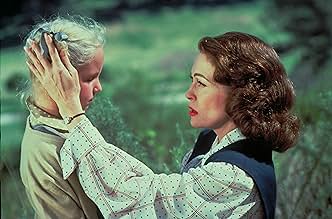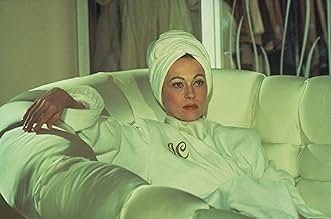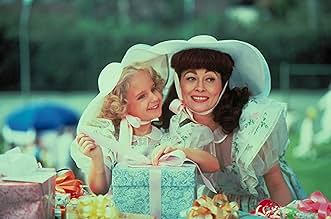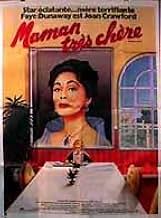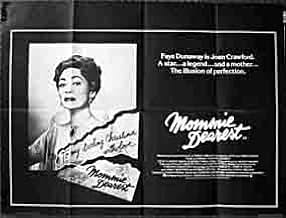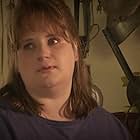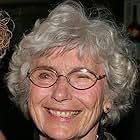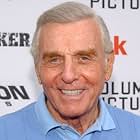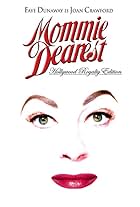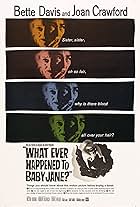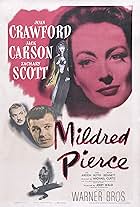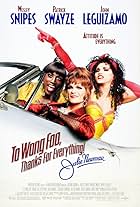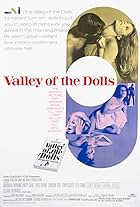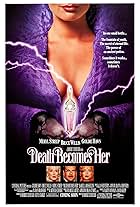The abusive and traumatic adoptive upbringing of Christina Crawford at the hands of her mother, screen queen Joan Crawford, is depicted.The abusive and traumatic adoptive upbringing of Christina Crawford at the hands of her mother, screen queen Joan Crawford, is depicted.The abusive and traumatic adoptive upbringing of Christina Crawford at the hands of her mother, screen queen Joan Crawford, is depicted.
- Awards
- 9 wins & 11 nominations
Storyline
Did you know
- TriviaFaye Dunaway mentions in her autobiography that she screamed herself hoarse during the filming for the notorious wire hanger tantrum scene in this movie. She called Frank Sinatra for help, and he gave her some pointers on how to get her voice back into shape.
- GoofsWhen Joan Crawford substitutes for her daughter on a soap opera, producer of show gives her a pep talk during a commercial, indicating it was a live broadcast. In reality 'The Secret Storm' was taped and director later said Crawford's performance was so poor he had to patch it together in editing room. Although it was recorded, The Secret Storm was "live tape", meaning that it was treated as if it were a live broadcast. At the end of each act, the actors stopped for the exact length of the commercials and then resumed taping.
- Quotes
[addressing the men in the Pepsi boardroom]
Joan Crawford: Don't fuck with me fellas. This ain't my first time at the rodeo.
- Alternate versionsDue to the damage on the film's master, all current video/television prints are missing the dramatic music as Joan destroys her rose garden.
- SoundtracksI'm Sitting On Top Of The World
by Sam Lewis, Joe Young (as Young) & Ray Henderson (as Henderson)
Featured review
Given the film's current cult movie status one is tempted to believe the 1981 MOMMIE DEAREST was a critical debacle and a box office fiasco. That is not really the case. It is true that critics generally considered the film a failure, but many of them admired certain elements of it; it is also true that box office fell below expectations, but it was not a box office disaster in the same sense as the 1980 HEAVEN'S GATE or the 1981 INCHON.
It is also true, however, that audiences howled with laughter at the film when it debuted, and although leading lady Faye Dunaway received a number of critical accolades for her performance as Joan Crawford, she also received an equal number of devastating reviews--and it was these that caught the spotlight. It was a humiliating experience for an actress particularly noted for her perfectionism, and rumor has it that Dunaway feels the film ended her career as a major film star. Whatever the case, Dunaway quickly developed a strategic silence about the film that she has maintained for some two decades.
Seen today, it is easy to identify the core problems of the film. The most obvious is the script, which is extremely inconsistent in quality and yet perversely consistent in a style that can only be described as soap opera hot-house to the nth degree. This is particularly true of the dialogue assigned to Dunaway. Infamous lines such as "No More Wire Hangers Ever," "Tina! Bring Me The Axe," and "I'm Not Mad At You, I'm Mad At The Dirt" have become a staple of every drag queen from Maine to California.
But the ultimate disaster here is director Frank Perry. Joan Crawford was a larger-than-life personality; the role is written to reflect this; Dunaway plays the role as it was written. But it would seem Perry sought to heighten the effect: the rest of the cast is extremely, extremely restrained. This must have seemed like a good idea in theory, but it proves a terrible mistake in actual fact. No matter what Dunaway does with it, she can NEVER seem less than wildly overwrought in comparison to the rest of the cast, and the effect is very peculiar indeed.
The designs and the cinematography also clash in an incredibly bizarre way. There is absolutely no doubt that everything about the film is exactingly accurate: that is indeed the look of the period, right down to the very last detail. But the photography is extremely flat, and you are constantly aware that the sets are indeed movie sets, the costumes are movie costumes, and so on. Yes, it is all beautifully rendered, but you can't buy into it as anything real.
The Hollywood Royalty Edition DVD edition offers a good but by no means flawless print of the film and several bonuses. It is unfortunate that they are not particularly illuminating. While director John Water's commentary is enjoyable, he approaches the film only as a fan. Even so, Water does make several telling points: many of the things that Crawford does which seem so odd (bathing the face in ice, for example) are actually commonplace cosmetic necessities for movie stars; many of the things the film treats as abuse were, although carried to wild extremes in the story, typical of child-rearing practices of the 1940s and 1950s.
There are also three short documentaries featuring a number of cast members, most notably Diana Scarwid; these are actually entertaining for the fact that those who appear still seem to regard the film as "a good movie." The only really significant interview is with Lypsinka, an artist who has driven Crawford impersonations to the level of wicked satire and high art, and who offers a number of interesting personal insights into the iconography involved.
Like the film itself, the bonus package has two great failures. The first is that Faye Dunaway does not appear in interview or commentary; it would be very interesting to have her own take on the film, its failures, and its afterlife. Given her sentiment, it is an understandable non-involvement; less understandable, however, that there is not so much as a potted biography of the actress--or indeed of any member of the cast, for there are no written notes of any kind.
The second great failure of the bonus package is that it contains no factual information on either Joan or Christina Crawford. There is no indication here that those who knew both women are sharply divided over the accuracy of the portraits both here and in the book by Christina Crawford from which the film is drawn. A number of people, including actresses Betty Hutton and June Allyson, supported Christina Crawford's accounts, but an equal number, including actress Myrna Loy and Christina's younger siblings, flatly stated that Christina's accusations were largely fictitious.
When all is said and done, and in spite of performances and moments that are actually extremely good in isolation, MOMMIE DEAREST is a film that falls under the "so bad it's good" category of cult films. While I am taken aback by the bizarre nature of the movie, I personally find the amusement involved almost as dark as the movie's plot; it is not among my cult film favorites. Even so, I can understand the appeal it has for others, and I give it five stars on that basis.
GFT, Amazon Reviewer
It is also true, however, that audiences howled with laughter at the film when it debuted, and although leading lady Faye Dunaway received a number of critical accolades for her performance as Joan Crawford, she also received an equal number of devastating reviews--and it was these that caught the spotlight. It was a humiliating experience for an actress particularly noted for her perfectionism, and rumor has it that Dunaway feels the film ended her career as a major film star. Whatever the case, Dunaway quickly developed a strategic silence about the film that she has maintained for some two decades.
Seen today, it is easy to identify the core problems of the film. The most obvious is the script, which is extremely inconsistent in quality and yet perversely consistent in a style that can only be described as soap opera hot-house to the nth degree. This is particularly true of the dialogue assigned to Dunaway. Infamous lines such as "No More Wire Hangers Ever," "Tina! Bring Me The Axe," and "I'm Not Mad At You, I'm Mad At The Dirt" have become a staple of every drag queen from Maine to California.
But the ultimate disaster here is director Frank Perry. Joan Crawford was a larger-than-life personality; the role is written to reflect this; Dunaway plays the role as it was written. But it would seem Perry sought to heighten the effect: the rest of the cast is extremely, extremely restrained. This must have seemed like a good idea in theory, but it proves a terrible mistake in actual fact. No matter what Dunaway does with it, she can NEVER seem less than wildly overwrought in comparison to the rest of the cast, and the effect is very peculiar indeed.
The designs and the cinematography also clash in an incredibly bizarre way. There is absolutely no doubt that everything about the film is exactingly accurate: that is indeed the look of the period, right down to the very last detail. But the photography is extremely flat, and you are constantly aware that the sets are indeed movie sets, the costumes are movie costumes, and so on. Yes, it is all beautifully rendered, but you can't buy into it as anything real.
The Hollywood Royalty Edition DVD edition offers a good but by no means flawless print of the film and several bonuses. It is unfortunate that they are not particularly illuminating. While director John Water's commentary is enjoyable, he approaches the film only as a fan. Even so, Water does make several telling points: many of the things that Crawford does which seem so odd (bathing the face in ice, for example) are actually commonplace cosmetic necessities for movie stars; many of the things the film treats as abuse were, although carried to wild extremes in the story, typical of child-rearing practices of the 1940s and 1950s.
There are also three short documentaries featuring a number of cast members, most notably Diana Scarwid; these are actually entertaining for the fact that those who appear still seem to regard the film as "a good movie." The only really significant interview is with Lypsinka, an artist who has driven Crawford impersonations to the level of wicked satire and high art, and who offers a number of interesting personal insights into the iconography involved.
Like the film itself, the bonus package has two great failures. The first is that Faye Dunaway does not appear in interview or commentary; it would be very interesting to have her own take on the film, its failures, and its afterlife. Given her sentiment, it is an understandable non-involvement; less understandable, however, that there is not so much as a potted biography of the actress--or indeed of any member of the cast, for there are no written notes of any kind.
The second great failure of the bonus package is that it contains no factual information on either Joan or Christina Crawford. There is no indication here that those who knew both women are sharply divided over the accuracy of the portraits both here and in the book by Christina Crawford from which the film is drawn. A number of people, including actresses Betty Hutton and June Allyson, supported Christina Crawford's accounts, but an equal number, including actress Myrna Loy and Christina's younger siblings, flatly stated that Christina's accusations were largely fictitious.
When all is said and done, and in spite of performances and moments that are actually extremely good in isolation, MOMMIE DEAREST is a film that falls under the "so bad it's good" category of cult films. While I am taken aback by the bizarre nature of the movie, I personally find the amusement involved almost as dark as the movie's plot; it is not among my cult film favorites. Even so, I can understand the appeal it has for others, and I give it five stars on that basis.
GFT, Amazon Reviewer
Details
- Release date
- Country of origin
- Language
- Also known as
- Meine liebe Rabenmutter
- Filming locations
- 355 S. Mapleton Drive, Holmby Hills, Los Angeles, California, USA(pool-area and rear of Joan Crawford's house, demolished)
- Production company
- See more company credits at IMDbPro
Box office
- Budget
- $5,000,000 (estimated)
- Gross US & Canada
- $19,032,261
- Gross worldwide
- $19,034,156
- Runtime2 hours 9 minutes
- Sound mix
- Aspect ratio
- 1.85 : 1
Contribute to this page
Suggest an edit or add missing content




